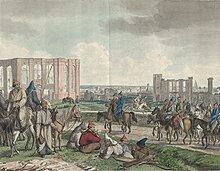Pesthof

The Pesthof (later the hospital ) was a premodern facility for the reception and care of the sick and needy in Hamburg . It was built in 1606 on the Hamburger Berg (today St. Pauli) and accommodated up to 1000 sick people and other needy people. During the French occupation of Hamburg it was demolished in 1814 and replaced by the General Hospital St. Georg in 1823 .
history
The foundation of the Pesthof was related to recurring plague epidemics in the 15th and 16th centuries. In contrast to leprosy and other infectious diseases, which only affected limited and easily isolable parts of the population, the plague claimed large numbers of victims from all social classes in a short time. Since the medieval hospitals ( Heiligengeist , Job , St. Georg ) were unable to cope with so many sick people, the plague sufferers were initially housed in temporary hospitals in front of the city gates - in the area of today's Neustadt - and also buried here after death .

At the beginning of the 17th century, the area of the new town was already so densely populated that some of the houses were directly adjacent to the old plague hospitals. On the occasion of another epidemic outbreak in 1604, the council and citizens decided to found a new “Pesthof” on the Hamburger Berg, halfway to the neighboring town of Altona . The area was located south of today's Clemens-Schultz-Straße, at the corner of Annenstraße, and comprised several buildings, including a “madhouse” for the mentally ill. The Pesthof was not a municipal institution, but a civic foundation like the medieval hospitals, as there was also in the Pesthof or hospital the possibility to buy a retirement home. There was a separate pastor's office to look after the residents. In 1768/69 Johannes Kopp built the octagonal Pesthof Church based on the design by Cai Dose for the Horn Church .
In the siege winter of 1813/14 , the hospital and the church as well as the entire area were burned down by the French occupiers in order to create a clear field of fire against advancing besiegers. The sick were driven away. About 800 of them were accommodated in the Johanniskirche in Eppendorf, where a typhus epidemic wiped out many. The last remaining sick were evacuated to the guest and hospital on the banks of the Alster.
As a replacement for the hospital , the General Hospital in St. Georg, newly built by Carl Ludwig Wimmel, was opened as the first municipal sanatorium.
literature
- Heinz Rodegra: From Pesthof to General Hospital. The development of the hospital system in Hamburg at the beginning of the 19th century , Münster 1977.
- Dieter Boedecker: The development of the Hamburg hospitals from the foundation of the city up to 1800 from a medical point of view , Hamburg 1977, pp. 229–326.
- G. Herman Sieveking : On the building history of the Pesthof in Hamburg , Hamburg 1940. [Special print from: Hamburgische Geschichts- und Heimatblätter Vol. 12 (1939/40)]
Coordinates: 53 ° 33 '8.9 " N , 9 ° 57' 52.5" E